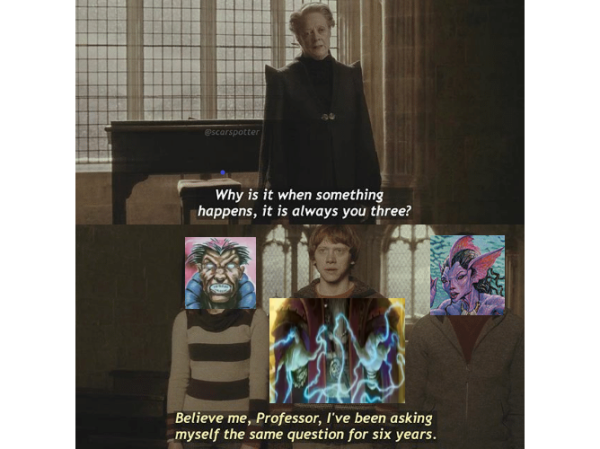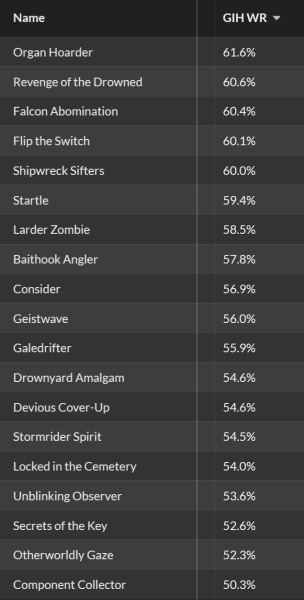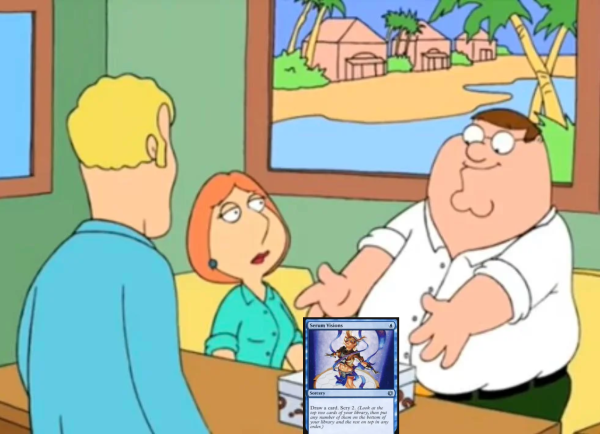Are you a Quiet Speculation member?
If not, now is a perfect time to join up! Our powerful tools, breaking-news analysis, and exclusive Discord channel will make sure you stay up to date and ahead of the curve.
Cantrips are often times considered among the better cards in many high-powered formats. Legacy is defined by Brainstorm. Ponder and Preordain were both banned from Modern. In high-powered cubes, these cards are early picks. In many lower-powered draft formats, players seem less excited about taking them. They are picked later in drafts and are included in the final deck far less often.
What are Cantrips?
A cantrip is defined, by the MTG Wiki, as "a spell that draws a card in addition to its other effects (usually minor) and can therefore be said to replace itself." Typically these cards cost U or 1U and are instants or sorceries.
The Infamous
In theory, the idea is that these cards cost very little and offer a minor advantage, that can scale depending on a number of variables. The primary function they offer is replacing themselves. The cost is low. The advantages can vary. For example:
- Cost: Extremely low - U or two life.
- Advantage: Knowledge of your opponents hand.
- Abused advantage: Gitaxian Probe, being a potentially "free" spell, can contribute to storm or delirium, while serving as fodder for delve costs, and cards like Snapcaster Mage or Yawgmoth's Will.
Gitaxian Probe seems like a harmless card, but it is easy to use it to gain an advantage thanks to its low cost. There are many opportunities in a game of Magic to gain advantages when you cast instants, sorceries, or spells in general; have cards in your graveyard; play multiple spells in a turn; draw multiple cards in a turn, etc. Cantrips do a good job of checking all of these boxes, to the point that whole deck strategies have been built around them (more on that in a bit). The fact that this one can do so for zero mana is very powerful. Finally, it replaces itself, so you haven't lost a resource.
It's All Upside

An understanding of cantrips must start with the holy trinity: Brainstorm, Ponder, and Preordain. This trio finds its way into many of the most powerful blue decks in the most powerful formats. Why? For a low price, these cards offer utility and replace themselves. This means that by playing four copies of all three, a constructed deck essentially reduces its card count from a minimum of sixty cards to forty-eight. Of those forty-eight cards, the player will have more control over which ones they see. These small tools offer a rare consistency. Sometimes they offer more.
Preordain and Ponder play similarly. Preordain provides a scry two before replacing itself, helping you to clear clunkers and set up the next series of plays. Ponder allows you to arrange the top three or shuffle the deck and draw randomly. If you're looking for a specific card or a specific type of card, Ponder gives you four cracks at it. If you're looking to smooth out draws at the beginning of the game Preordain is a premium option.
Brainstorm is the trickiest of the bunch. It expands your hand by drawing three cards, before selecting two to reside at the top of your deck. Without further help, this effect is relatively low impact, as you will draw those cards in the coming turns. However, if you can shuffle away two lesser cards, Brainstorm can feel like a draw three. Giving yourself that much control over your deck is powerful, especially if you're using those very cards to flip Delver of Secrets, trigger Young Pyromancer or Adeliz, the Cinder Wind, cast Murktide Regent, etc. These little tools can offer tons of value to the right deck.
Turbo Xerox Mindset
Turbo-Xerox is a term for strategies that use a high cantrip count to control draws. This creates an artificially high creature and land count while dedicating less space to those types of cards.
UR Aggro - Gul_Dukat - MTGO Showcase Challenge, 9th Place
This deck only has fourteen lands. Ponder, Brainstorm, Mishra's Bauble, and Expressive Iteration create velocity. The player sees more cards each turn and as a result, can draw lands reliably. These decks are still dominating the format.
Additionally, the high spell count fuels many of the deck's best threats. All of the creatures, besides the singleton Brazen Borrower, benefit from the spell density in the deck. They help Ledger Shredder, Delver of Secrets, and Dragon's Rage Channeler grow in size while further controlling draws and they help Murktide Regent hit the table earlier.
Similarly, decks like UR Aggro, RUG Delver, and Death's Shadow in Modern and Legacy all benefit from the Turbo Xerox strategy.
Cantrips in Draft: Mysteries in Midnight Hunt
Innistrad: Midnight Hunt (MID) offered three cards that could be described as cantrips at common. Two were instants and one was a sorcery. Below are the overall rankings of all blue commons, by game-in-hand win rate, according to 17lands.com.

The Good: Consider is a very traditional cantrip. If you cast it with mana that you otherwise would not have used then theoretically your deck is objectively better having included the Consider. Spending one mana uses no more resources than leaving one unused. But the cantrip is better than just a card. It's a selected card. At any given time, every card in our deck has an equal chance of being drawn. A card like Consider lets us improve those odds towards the cards we want.
The Bad: Secrets of the Key is a bad card. Paying three mana for a card to replace itself is too much. Yes, you can, later on, pay four mana to get the opportunity to pay two mana for a card two more times, but this rate is the antithesis of what cantrips are supposed to do. They are supposed to be cheap upgrades to your resources. This is an inefficient card draw spell disguised as a cantrip.
The Startling: Startle had the biggest impact on players' win rates. Two mana is a lot for a cantrip, but this card could serve as much more. This card is a combat trick that can impact the board in addition to being a cantrip. It also leaves behind a meager body in a decayed zombie token.
Startling Development
When I first saw Startle I assumed it would be strong. For two mana, it offers a lot of versatility. It can be cycled to prevent damage or to look for land early on. Opportunistic players can turn this combat trick into a removal spell. The zombie can even be used for Skaab Wrangler or Larder Zombie. You can sacrifice it. You can alpha-strike with it. Even if you don't get much value from the token, and even if the combat trick was low impact, you still get a card. Startle gives you all this plus the card that you would have drawn, if you didn't put Startle in the deck.
This style of cantrip has become popular and powerful. Kamigawa Neon Dynasty (NEO) and Streets of New Capenna (SNC) have two very similar combat tricks. Suit up and Majestic Metamorphosis use the Startle model to have an even bigger impact on combat. The typical play pattern is attacking with an undersized creature, getting blocked, and casting the combat trick so that you win the combat and draw the card. Without the card draw aspect, we would rarely want them in our deck. For example, Mordenkainen's Polymorph boasts a strictly unplayable game-in-hand win rate of 45.3%. It's unclear to me where the line is between cantrip and combat trick when it comes to these cards. However, the value is clear.
In Limited, where removal is more precious and less efficient, it is a safer expectation that these effects will resolve. In Constructed, their fragility makes them unplayable. Conversely, the effects provided by cards like Consider are hard to disrupt. Relying on these low costed spells is more powerful, as they will be finding the powerful cards in your constructed deck.
The Value of "Draw a Card"
Cantrips are superior in Constructed because of the other cards in the deck. Synergies aside, we build Constructed decks with the best cards possible. We select each inclusion with thoughtful analysis. In Draft, we build with what we get. Being limber while accessing a well-crafted Constructed deck lets you play towards familiar situations with well-prepared recourse.
In Draft, you have to select a cantrip at the expense of another card that could have made your deck. This implies that the rest of your cards would be less powerful. For instance, Galedrifter was a card I would often play. I'd rather have one in my pool than not. If I pass that card over Consider, a card with a very similar game-in-hand win rate, what am I saying?
When we navigate drafts, we find ourselves in nuanced situations. I might need a four-drop, a flyer, a card with disturb, or a midrange threat for all the normal reasons. I would select Consider if I wanted better selection in an already powerful deck. Additionally, cheap spells and sending cards to the graveyard might be good in my deck. If I already have Festival Crasher, Thermo-Alchemist and Seize the Storm than Consider will be powerful. If I have a lot of disturb, than Consider can help enable my graveyard while netting a resource. For one mana, I'm getting more than a card in those decks.
But even without those synergies, if I know my deck has strong tools the cantrip lets me utilize them better. Most cards are what they say they are. The cantrip could be anything.

What To Look For
We can consider the possibilities of what card(s) you want to draw in a given situation. We can rank every possible card in our deck in order of the most coveted draw to the least. This is true for every draw over the course of the game. Streamlining strong decks is often better than adding another copy of a replaceable effect.
If Your Deck Has Good Cards, These Are Good Cards
The best cards provide agency. The worst feeling in a game of Magic the Gathering is the sense that you have no control over the outcome of the game. Cards like Opt and Serum Vision give you small options that can impact the trajectory of the game. Scrying a card to the bottom of your library and drawing an extra one accelerates every draw in your deck by two turns.
Draw A Card Plus Synergy
Synergies are harder to build in Draft. Spirited Companion and Setessan Training both replace themselves like any good cantrip would. However, the fact that these cards are enchantments in formats that offers benefits for enchantments is extremely important. The aura could trigger both heroic or constellation in Theros Beyond Death (THB), whereas the dog helped enable enchantment payoffs in NEO.
Thought Scour is just Dark Ritual, draw a card in decks looking to delve out Gurmag Anglers. In Draft, cards that replace themselves while enabling our plan are extremely valuable.
Cost-Reward Analysis
The two major costs of a cantrip are the mana they cost and the slots they take up in deck construction. Both of these costs are relatively low, but one instance of card selection isn't an overwhelming advantage. In most Limited formats, it is impossible to build a Turbo-Xerox deck. The benefits are still there, however, and if we can generate small synergies these cantrips become powerful inclusions.
The reason why Spirited Companion was the second-best white common, and third-best common overall in NEO was because it was a cantrip that provided synergy. Cantrips will always be a reasonable inclusion to any deck because they represent another card in that deck. When we start getting additional value from the cantrip itself, that's when we have a winning strategy.
In Throne of Eldraine (ELD) Opt was more than just the card that replaced it. It was a trigger for Faerie Vandal and Improbable Alliance. In MID, Consider put disturb cards into the graveyard for additional value. Startle, Majestic Metamorphosis, and Suit Up are valuable in combat, which is a latent-synergy to almost any Limited deck.
Cantrips will never be a disaster on their own. If your deck has powerful cards, especially if those cards thrive in specific situations, the cantrips will be even better. However, if you can maximize the value of these cheap spells with other synergies, then you will be card drawing like a Legacy player. Don't be afraid to take a cantrip over filler when drafting a deck. If you trust the cards that you have, and you trust the decisions you are going to be able to make, then you'll always benefit from having more agency.





Card advantage is the game’s most defining strategy. Two cards for the price of one. The other way of seeing it is that it increases your opening hand by one.